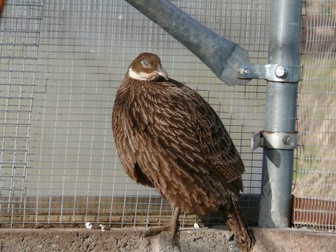Himalayan Monal
Recently, survey carried out in Arunachal Pradesh discovered a new type of Lophophorus species and its identity, though believed to be a subspecies of Sclater's Monal or a potential new species, is yet to be confirmed. There is, so far, no confirmed record of subspecies in the Himalayan Monal. However, recent studies have shown that the male Himalayan Monals of northwestern India lack the white rump that many Himalayan Monals have, and have more green on the breast, indicating the possibility of a second subspecies.

Original source: Unknown avian at Fife Animal ParkUploaded by Snowmanradio
Author: Brian Forbes from Kinross, ScotlandCamera location
The Himalayan Monal is classified as Least Concern. Does not qualify for a more at risk category. Widespread and abundant taxa are included in this category.
Himalayan Monals of northwestern India lack the white rump that many Himalayan Monals have, and have more green on the breast, indicating the possibility of a second subspecies. The scientific name commemorates Lady Mary Impey, the wife of British chief justice of Bengal, Sir Elijah Impey. More
The Himalayan Monal secures a distinct position among pheasants due to its prominent build, brilliant plumage and strong association with local folklore. Its natural range spreads from eastern Afghanistan through the Himalayas including Kashmir region of Northern Pakistan, India (states of Himachal Pradesh, Uttarakhand, Sikkim and Arunachal Pradesh), Nepal, southern Tibet and Bhutan. There is also a report of its occurrence in Burma. More
The Himalayan Monal Pheasant (Lophophorus impejanus) is also regionally known as the Impeyan Monal or Impeyan Pheasant. Distribution & Habitat: They are endemic to the Himalayas, eastern Afghanistan to western China. They can be found in Bhutan and countries of Pakistan, India (states of Jammu & Kashmir, Himachal Pradesh, Uttaranchal, Sikkim and Arunachal Pradesh), Nepal, and Southern Tibet. There is also a report of its occurrence in Myanmar. More
Status in Aviculture: The Himalayan Monal is the most commonly kept species of the genus Lophophorus and are well established in North American and European aviaries. Breeding Season: Begins late April Breeding Age: Second year. Clutch Size: 4 to 6 Incubation Period: 28 days Misc. Aviculture Notes: Impeyans need to housed in a large, well-drained aviary. More
the Himalayan monal has also been reported from Burma (2). View a distribution map for this species at UNEP World Conservation Monitoring Centre. Habitat - During the summer months, the Himalayan monal ventures above the tree-line to wander on the grassy slopes, but during winter it is found in coniferous and mixed forests with a high proportion of rhododendrons and bamboo, where it shelters from the weather. More
The male Himalayan Monals have bright and colorful feathers of blue, green, purple, and red. They have a white patch of feathers underneath the base of their tail, but the rest of their underside is black. The males also have a crest on top of their heads. Both the male and female of the species have blue circles of skin around their eyes. The females and the chicks have an overall brown appearance. Their feathers also have white and black strips on certain parts. More
the Himalayan Monal also undertakes an annual migration, but to a lesser degree. During winter this species can be located at the lower end of its altitude distribution but not necessarily in an area of differing aspect. In general the Western Tragopan and the Himalayan Monal occupy the same blocks of forest and can be observed together throughout the year. More
Himalayan Monal, Bird - Informative & researched article on Himalayan Monal, Bird Indianetzone: Largest Free Encyclopedia of India with thousand of articles Flora & Fauna in Art & Culture | Entertainment | Health | Reference | Sports | Society | More
The Himalayan Monal is a large heavily built bird and yet it is very gentle and good natured. The plumage of the mature male is spectacular. It consists mainly of metallic colours including blue, green, red and purple. He has a shimmering crest with the same metallic properties. He also has a short brown tail and a white patch on the rump. All of the front from the throat down is black. More
Himalayan Monal Organic Cotton TeeHimalayan Monal Organic Cotton Tee £18.50 Himalayan Monal Ash Grey T-ShirtHimalayan Monal Ash Grey T-Shirt £15.00 Himalayan Monal Green T-ShirtHimalayan Monal Green T-Shirt £15.00 Himalayan Monal Men's Sleeveless TeeHimalayan Monal Men's Sleeveless Tee £15.00 Himalayan Monal Jr. Ringer T-ShirtHimalayan Monal Jr. Ringer T-Shirt £16. More
Environmentalists fear over Himalayan Monal's extinction - Aug 27, 2005 Pay-Per-View - Hindustan Times - Factiva, from Dow JonesThe reason, a drastic decline in the number of Himalayan Monal. A pheasant earlier found all over the Western Himalayas, the fowl is fast disappearing due ... Zoo's male Himalayan monal pheasant dies - Oct 2, 2009 $2. More
The Himalayan Monal is the national bird of Nepal. Its alternative name of Impeyan comes from Lady Impey, who first kept them in captivity. Scientific Classification phylum Chordata subphylum Vertebrata class Aves order Galliformes family Phasianidae subfamily Phasianinae genus & species Gallus gallus Questions or comments about this page? ARKive. www.arkive.org/species/GES/birds/Lophophorus_impejanus/ WhoZoo. whozoo.org/Intro2003/AprilStJ/AS-himalayanMonalfinal. More

Original source: Bas Kers
Author: Bas Kers
Permission: Some rights reserved
Family : Phasianidae
Genus : Lophophorus
Species : impejanus
Authority : (Latham, 1790)
